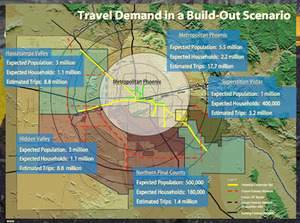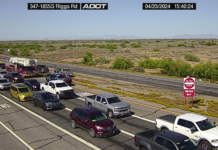
Hidden Valley and northern Pinal County’s populations are expected to reach 3.5 million by 2050, which is why City of Maricopa officials and other regional stakeholders are looking for ways to manage future traffic development.
The city recently became a funding partner for the Interstates 8 and 10-Hidden Valley Roadway Framework Study that is taking a comprehensive look at regional transportation needs.
“The study is to get them to the talking stages, conceptualizing,” said Bob Hazlett, a project manager with Maricopa Association of Governments (MAG). “Real recommendations will come around the end of year.”
The project began following the completion of the Hassayampa Valley Roadway Framework Study in March that looked at various projects like the Loop 303, which will provide an outer tier freeway system that will circle the Valley. Whether it is Loop 303 or another freeway system, experts are saying they need something to connect all of the growth.
“There needs to be something to connect cities like Goodyear, Buckeye and Maricopa to Casa Grande,” said Hazlett.
Transportation experts at MAG – the Hidden Valley study managers – are estimating this region of northern Pinal County and Southwestern Maricopa County will have 10.2 million vehicle trips in and around the region per day.
They estimate this type of traffic will require $75 billion worth of transportation investment, which currently does not exist.
Maricopa’s Transportation Manager Brent Billingsley said it is important to look at traffic needs this way. He said that this type of study could provide “boundless solutions.”
“It can give us the tools we need to control our own destiny,” said Billingsley.
Billingsley said that a common problem with many transportation studies is that they set limitations to solving problems like only looking to build freeways and highways.
He said that the Hidden Valley study is different because it looks at solving the problems without setting limitations. This study plans to incorporate regional planning for freeways, state highways, parkways, boulevards and major arterial level roadways and and to find creative solutions to fund them.
Billingsley said that having the flexibility to build smaller roadways that can develop into larger highways is an important part of future growth. He said developers could play a greater role in providing the necessary infrastructure that will solve their transportation problems today, rather than waiting for state or federal funding.
Something development advocates see as a problem with state and federal funding is the flat tax on gas that generates the revenues. Having a flat tax, rather than a percentage tax, means that when gas prices go up, the tax stays the same. That, combined with more fuel-efficient cars and inflation, is eating away at those funds.
One of the proposed solutions is allowing developers, or a combination of stakeholders, to build the necessary roadways based on where they want their developments to go.
To do this, they will need to find corridors that will give them the right-of-way as they build.
Billingsley said identifying this need comes from the Federal government’s inability to widen Interstate 10 to relieve congestion between Phoenix and Tucson. The Gila River Indian Community owns the right of way through the area to the south of Phoenix and won’t allow for expansion.
Both Billingsley and Hazlett said there needs to be an alternate route to the west of Maricopa that will provide congestion relief as well as allowing for future growth.
Hazlett said they also recognize developers’ need for connections between the Hidden Valley and Hassayampa Valley regions.
This expanding trend doesn’t stop with the merging of cities and counties. Hazlett said Arizona and Nevada are the fastest growing states in the country, and there isn’t a freeway connecting Las Vegas and Phoenix. These studies could lead to traffic development patterns that merge entire states into what is being called megapolitans.
Megapolitans are byproducts of merging counties and states caused by real estate booms.
Virginia Tech urban planning professor Robert Lang predicts it will take 25 years to erect the next 200 billion square feet of urban development, which will accommodate 70 million more people.
He has named 10 regions in the country megapolitans, one of which is “Valley of the Sun” – the area that incorporates Tucson and Phoenix.
Before this can happen, though, the region needs to figure out what it wants to do and how it will pay for it.
“It takes investment,” said Hazlett. “Transportation systems are not free.”
He predicts that it will take 20 – 30 years to get the funding for the desired roadways.
What do we charge for growth?” he said, noting that it is pure economics in the end.
“The worst things we can do is bury our head in the sand on this issue.”
For more information about MAG and transportation studies visit: www.mag.maricopa.gov.
Illustration courtesy of MAG





![Maricopa’s ‘TikTok Rizz Party,’ explained One of several flyers for a "TikTok rizz party" is taped to a door in the Maricopa Business Center along Honeycutt Road on April 23, 2024. [Monica D. Spencer]](https://www.inmaricopa.com/wp-content/uploads/2024/04/spencer-042324-tiktok-rizz-party-flyer-web-218x150.jpg)






![Alleged car thief released without charges Phoenix police stop a stolen vehicle on April 20, 2024. [Facebook]](https://www.inmaricopa.com/wp-content/uploads/2024/04/IMG_5040-218x150.jpg)




